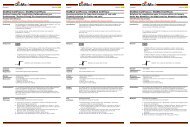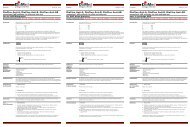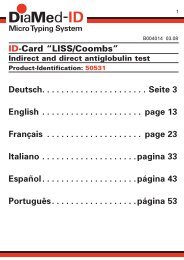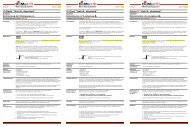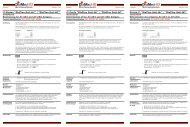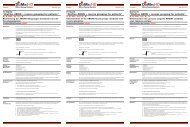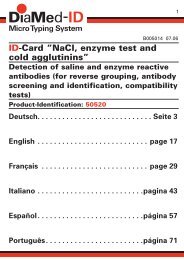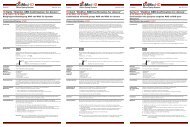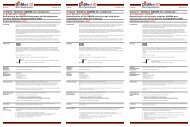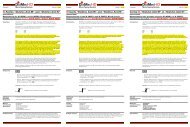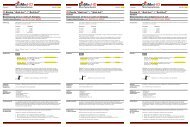ID-Diluent 1 ID-Diluent 1 ID-Diluent 1
ID-Diluent 1 ID-Diluent 1 ID-Diluent 1
ID-Diluent 1 ID-Diluent 1 ID-Diluent 1
Create successful ePaper yourself
Turn your PDF publications into a flip-book with our unique Google optimized e-Paper software.
Deutsch B009154 05.06 English B009154 05.06 Français B009154 05.06<br />
<strong>ID</strong>-<strong>Diluent</strong> 1<br />
Modifizierte Bromelinlösung für Blutgruppenbestimmung<br />
und Enzymtests<br />
Produkt-Identifikation: 05751<br />
<strong>ID</strong>-<strong>Diluent</strong> 1<br />
Modified Bromelin solution for blood grouping<br />
and enzyme tests<br />
Product-Identification: 05751<br />
<strong>ID</strong>-<strong>Diluent</strong> 1<br />
Solution de Bromeline modifiée, pour groupages<br />
et tests enzymatiques<br />
Identification de produit: 05751<br />
Einleitung<br />
Proteolytische Enzyme verändern Erythrozyten-Antigene und verbessern dadurch die Reaktivität einiger<br />
Antigen-/Antikörpersysteme während andere Antigene, wie beispielsweise M, N, S, Fy a und Fy b zerstört<br />
werden.<br />
Introduction<br />
Proteolytic enzymes modify red blood cell antigens and thus enhance the reactivity of some antigen/<br />
antibody systems and suppress others such as M, N, S, Fy a and Fy b .<br />
Introduction<br />
Les enzymes protéolytiques modifient les antigènes érythrocytaires et, par conséquent, favorisent la<br />
réactivité de certains systèmes antigène/anticorps alors qu’ils en suppriment d’autres, tels que M, N, S,<br />
Fy a et Fy b .<br />
Papain und Bromelin sind in der Blutgruppenserologie die am häufigsten eingesetzten Enzyme. Papain<br />
wird generell für die Enzymbehandlung roter Blutkörperchen vor ihrer Verwendung eingesetzt, während<br />
Bromelin darüber hinaus häufig als additives Reagenz genutzt wird.<br />
The most commonly used enzymes in blood group serology are papain and bromelin. Papain is<br />
generally used for enzyme treatment of red blood cells prior to their use, whereas bromelin in addition<br />
is often used as an additive reagent.<br />
Les enzymes les plus utilisées en immuno-hématologie sont la papaïne et la bromeline. La papaïne est<br />
utilisée, en général, pour le traitement des hématies avant leur utilisation, alors que la bromeline est en<br />
plus souvent utilisée comme réactif additif.<br />
“<strong>ID</strong>-<strong>Diluent</strong> 1” ist eine modifizierte Bromelin-Lösung, für das DiaMed-<strong>ID</strong> Micro Typing System mit<br />
langfristig stabilisierter Enzymaktivität. “<strong>ID</strong>-<strong>Diluent</strong> 1” wird für den Ansatz von Erythrozytensuspensionen<br />
für die Blutgruppenbestimmung verwendet und dient als Additiv für Enzymtests mit unbehandelten<br />
Erythrozyten im Rahmen des Antikörpernachweises und Verträglichkeitstests.<br />
”<strong>ID</strong>-<strong>Diluent</strong> 1” is a modified bromelin solution in which the enzyme activity is stabilised for a long<br />
period, specially prepared for the DiaMed-<strong>ID</strong> Micro Typing System. “<strong>ID</strong>-<strong>Diluent</strong> 1” is used for preparing<br />
suspensions of red cells for blood grouping and as an additive for enzyme tests with untreated red cells<br />
for antibody detection and crossmatching.<br />
L’”<strong>ID</strong>-<strong>Diluent</strong> 1” est une solution de bromeline modifiée, dont l’activité enzymatique est stable pendant<br />
une longue période, spécialement conçue pour le DiaMed-<strong>ID</strong> Micro Typing System. L’”<strong>ID</strong>-<strong>Diluent</strong> 1” est<br />
utilisée dans la préparation des suspensions d’hématies pour le groupage sanguin et, comme additif,<br />
sur des hématies non traitées, pour la recherche d’anticorps et l’épreuve croisée en technique<br />
enzymatique.<br />
Reagenzien<br />
Reagents<br />
Réactifs<br />
<strong>ID</strong>-<strong>Diluent</strong> 1: Modifizierte Bromelin-Lösung zur Herstellung der Erythrozytensuspension und Reagenz für<br />
Enzymteste, in 100 und 500 mL Flaschen.<br />
Konservierungsmittel: Antibiotika Trimethoprim und Sulfamethoxazol.<br />
<strong>ID</strong>-<strong>Diluent</strong> 1: modified bromelin solution for red cell suspension and reagent for enzyme tests, in 100<br />
and 500 mL vials.<br />
Preservatives: the antibiotics trimetoprim and sulfamethoxazole.<br />
<strong>ID</strong>-<strong>Diluent</strong> 1: solution de bromeline modifiée pour suspensions d’hématies et tests enzymatiques, en<br />
bouteille de 100 et 500 mL.<br />
Conservateurs: les antibiotiques trimétoprime et sulfaméthoxazole.<br />
Nach dem Öffnen ist das Produkt bei ordnungsgemäßer Lagerung bis zu 6 Monate haltbar.<br />
Once opened, and if stored correctly, the product can be used for up to 6 months afterwards.<br />
Après la première ouverture et stocké correctement, le produit peut être employé pendant 6 mois.<br />
Stabilität: siehe Verfallsdatum auf dem Etikett.<br />
Stability: see expiry date on label.<br />
Stabilité: voir date de péremption sur l’étiquette.<br />
Weitere<br />
erforderliche<br />
Materialien<br />
• <strong>ID</strong>-Dispenser<br />
• Pipette 25 und 50 µL<br />
• <strong>ID</strong>-Tips (Pipetor-Spitzen)<br />
• Suspensionsröhrchen<br />
• <strong>ID</strong>-Arbeitsplatz<br />
Further<br />
materials<br />
required<br />
• <strong>ID</strong>-Dispenser<br />
• Pipette 25 and 50 µL<br />
• <strong>ID</strong>-Tips (pipetor tips)<br />
• Suspension Tubes<br />
• <strong>ID</strong>-Working Table<br />
Matériaux<br />
supplémentaires<br />
nécessaires<br />
• <strong>ID</strong>-Dispenser<br />
• Pipette 25 et 50 µL<br />
• <strong>ID</strong>-Tips (cônes pour pipette)<br />
• Tubes pour suspensions<br />
• <strong>ID</strong>-Table de travail<br />
Probenmaterial<br />
Für verlässliche Resultate sollte die Bestimmung mit frisch abgenommenen Proben durchgeführt<br />
werden oder in Übereinstimmung mit lokalen Laborvorschriften für die Akzeptanz von Probenmaterial<br />
erfolgen. Vorzugsweise sollte die Probengewinnung in den Antikoagulantien Citrat, EDTA oder CPD-A<br />
erfolgen. Native Proben (kein Antikoagulanz) können auch verwendet werden.<br />
Wird Serum anstelle von Plasma verwendet, sollte dieses vor Testansatz 10 Minuten bei 1500 g<br />
zentrifugiert werden, damit keine störenden Fibrinreste in dem Testansatz gelangen.<br />
Sample material<br />
For optimal results, the determination should be performed using a freshly drawn sample, or in accordance<br />
with local laboratory procedures for sample acceptance criteria. Preferably, blood samples should<br />
be drawn into citrate, EDTA or CPD-A anticoagulant. Samples drawn into plain tubes (no anticoagulant)<br />
may also be used.<br />
When the use of serum instead of plasma is required, the serum must be well cleared, by centrifugation<br />
at 1500 g for 10 minutes, before use avoid fibrin residues, which may interfere with the reaction pattern.<br />
Echantillons<br />
Afin d’obtenir des résultats fiables, la détermination devrait se faire sur du matériel fraîchement prélevé<br />
ou conforme aux exigences du laboratoire auquel la demande d’analyses est adressée. L’échantillon<br />
devrait être prélevé de préférence sur anticoagulant citrate, EDTA ou CPD-A. Du sang prélevé sans<br />
anticoagulant (natif) peut également être utilisé.<br />
Lorsque l’utilisation de sérum est préférable à celle de plasma, le sérum doit être obtenu par<br />
centrifugation à 1500 g pendant 10 minutes pour éviter des résidus de fibrine qui pourraient interférer<br />
avec la réaction.<br />
Vorbereitung<br />
der Blutprobe<br />
A) Für die Blutgruppenbestimmung<br />
Eine 5%ige Erythrozytensuspension von Patientenerythrozyten in “<strong>ID</strong>-<strong>Diluent</strong> 1” wie folgt herstellen:<br />
Preparation<br />
of blood sample<br />
A) For blood group determinations<br />
Prepare a 5% red cell suspension of the patient’s red cells in “<strong>ID</strong>-<strong>Diluent</strong> 1” as follows:<br />
Préparation<br />
de l’échantillon<br />
de sang<br />
A) Pour la détermination de groupe sanguin<br />
Préparer une suspension d’hématies du patient à 5% en “<strong>ID</strong>-<strong>Diluent</strong> 1” comme suit:<br />
<strong>Diluent</strong> vor Gebrauch auf Raumtemperatur bringen.<br />
Allow the diluent to reach room temperature before use.<br />
Ramener le diluant à température ambiante avant utilisation.<br />
1. 0,5 mL “<strong>ID</strong>-<strong>Diluent</strong> 1” in ein sauberes Röhrchen pipettieren.<br />
2. 50 µL Vollblut oder 25 µL Erythrozytenkonzentrat zugeben, leicht mischen.<br />
3. Die Erythrozytensuspension 10 Minuten bei Raumtemperatur inkubieren.<br />
1. Dispense 0,5 mL of “<strong>ID</strong>-<strong>Diluent</strong> 1” into a clean tube.<br />
2. Add 50 µL of whole blood or 25 µL of packed cells, mix gently.<br />
3. Incubate the red cell suspension for 10 minutes at room temperature.<br />
1. Distribuer 0,5 mL d’”<strong>ID</strong>-<strong>Diluent</strong> 1” dans un tube propre.<br />
2. Ajouter 50 µL de sang total ou 25 µL de culot d’hématies; mélanger doucement.<br />
3. Incuber la suspension d’hématies 10 minutes à température ambiante.<br />
Innerhalb von 15 Minuten nach der Inkubation verwenden.<br />
Use within 15 minutes after incubation.<br />
Utiliser dans les 15 minutes qui suivent l’incubation.<br />
B) Als additives Reagenz für den Enzymtest (Antikörpersuchtest, Verträglichkeitstest)<br />
B) For use as enzyme reagent additive (antibody detection, crossmatch)<br />
B) Pour utilisation comme réactif enzymatique additif (recherche d’anticorps, épreuve croisée)<br />
<strong>Diluent</strong> vor Gebrauch auf Raumtemperatur bringen.<br />
Allow the diluent to reach room temperature before use.<br />
Ramener le diluant à température ambiante avant utilisation.<br />
Nach Pipettierung der 0,8%igen Erythrozytensuspension und des Serums oder Plasmas, 25 µL<br />
“<strong>ID</strong>-<strong>Diluent</strong> 1” in das entsprechende Mikroröhrchen der für den Test erforderlichen <strong>ID</strong>-Karte geben.<br />
After pipetting of the 0,8% red cell suspension and the serum or plasma sample to the appropriate<br />
microtubes of an <strong>ID</strong>-Card corresponding to the required test procedure, add 25 µL of “<strong>ID</strong>-<strong>Diluent</strong> 1” to<br />
each microtube.<br />
Après avoir distribué la suspension d’hématies à 0,8% et le sérum ou le plasma dans les microtubes<br />
appropriés de la carte-<strong>ID</strong> selon la procédure du test requis, ajouter 25 µL d’”<strong>ID</strong>-<strong>Diluent</strong> 1” dans le<br />
microtube correspondant de la carte-<strong>ID</strong>.<br />
Wichtig:<br />
Für eine präzise Durchführung die Packungsbeilage der jeweils verwendeten <strong>ID</strong>-Karte<br />
beachten!<br />
Important:<br />
consult the related instruction sheet of the <strong>ID</strong>-Cards for precise working procedures.<br />
Important:<br />
Pour les détails techniques, consulter les notices des cartes-<strong>ID</strong> correspondantes.<br />
Einschränkungen<br />
a) Bakterielle oder andere Kontaminationen des verwendeten Materials können falsch positive oder<br />
falsch negative Ergebnisse verursachen.<br />
b) Striktes Befolgen der Anleitungen und Verwendung des erforderlichen Arbeitmaterials sind<br />
unerlässlich. Das Arbeitsmaterial sollte regelmässig entsprechend der GLP-Richtlinien überprüft<br />
werden.<br />
Limitations<br />
a) Bacterial or other contamination of materials used can cause false positive or false negative results.<br />
b) Strict adherence to the procedures and recommended equipment is essential. The equipment should<br />
be checked regularly according to GLP procedures.<br />
Limites<br />
a) Des contaminations, bactériennes ou autres, du matériel utilisé peuvent provoquer des résultats<br />
faussement positifs ou faussement négatifs.<br />
b) L’observation stricte des méthodes et l’emploi de l’équipement recommandé sont essentiels.<br />
L’équipement doit étre régulièrement contrôlé selon les procédures des BPL.<br />
Literatur<br />
1. Technical Manual; 11 th ed. 1993; American Association of Blood Banks.<br />
2. Mollison, P.L., Engelfriet, C.P. and Contreras, M.: Blood Transfusion in Clinical Medicine, 9 th ed. 1993;<br />
Blackwell Scientific Publications, Oxford.<br />
3. Issitt, P.D. Applied Blood Group Serology, 3 rd ed. 1985; p: 222; Montgomery Scientific Publications,<br />
Miami, Florida, U.S.A.<br />
4. Lapierre, Y., Rigal, D., Adam, J. et al.: The gel test; A new way to detect red cell antigen-antibody<br />
reactions. Transfusion 1990; 30: 109–113.<br />
Bibliography<br />
1. Technical Manual; 11 th ed. 1993; American Association of Blood Banks.<br />
2. Mollison, P.L., Engelfriet, C.P. and Contreras, M.: Blood Transfusion in Clinical Medicine, 9 th ed. 1993;<br />
Blackwell Scientific Publications, Oxford.<br />
3. Issitt, P.D. Applied Blood Group Serology, 3 rd ed. 1985; p: 222; Montgomery Scientific Publications,<br />
Miami, Florida, U.S.A.<br />
4. Lapierre, Y., Rigal, D., Adam, J. et al.: The gel test; A new way to detect red cell antigen-antibody<br />
reactions. Transfusion 1990; 30: 109–113.<br />
Bibliographie<br />
1. Technical Manual; 11 th ed. 1993; American Association of Blood Banks.<br />
2. Mollison, P.L., Engelfriet, C.P. and Contreras, M.: Blood Transfusion in Clinical Medicine, 9 th ed. 1993;<br />
Blackwell Scientific Publications, Oxford.<br />
3. Issitt, P.D. Applied Blood Group Serology, 3 rd ed. 1985; p: 222; Montgomery Scientific Publications,<br />
Miami, Florida, U.S.A.<br />
4. Lapierre, Y., Rigal, D., Adam, J. et al.: The gel test; A new way to detect red cell antigen-antibody<br />
reactions. Transfusion 1990; 30: 109–113.<br />
Produkte <strong>ID</strong>-<strong>Diluent</strong> 1 2 x 100 mL . . . . . . . . . . . . . . . . . . . REF 009160<br />
1 x 500 mL . . . . . . . . . . . . . . . . . . . REF 009180<br />
Products <strong>ID</strong>-<strong>Diluent</strong> 1 2 x 100 mL . . . . . . . . . . . . . . . . . . . REF 009160<br />
1 x 500 mL . . . . . . . . . . . . . . . . . . . REF 009180<br />
Produits <strong>ID</strong>-<strong>Diluent</strong> 1 2 x 100 mL . . . . . . . . . . . . . . . . . . . REF 009160<br />
1 x 500 mL . . . . . . . . . . . . . . . . . . . REF 009180<br />
Für diese Produkte wird nur Garantie übernommen, wenn sie gemäss den Angaben auf dem Etikett und<br />
der Anwendungsvorschrift verwendet werden. Jegliche Verantwortung wird ausdrücklich abgelehnt,<br />
wenn das Präparat für andere Zwecke gebraucht oder verkauft wird.<br />
These products are guaranteed to perform as described on the label and in the instruction sheet. The<br />
manufacturer declines all responsibility arising out of the use or sale of these products in any way or for<br />
any purpose other than those described therein.<br />
Ces produits sont garantis quant à leurs propriétés et qualités stipulées sur l’étiquette et dans le mode<br />
opératoire. Le fabricant décline toute responsabilité pour les cas où ces produits seraient employés ou<br />
vendus à d’autres usages.<br />
DiaMed AG, 1785 Cressier s/Morat, Schweiz 0123 DiaMed AG, 1785 Cressier s/Morat, Switzerland 0123 DiaMed SA, 1785 Cressier s/Morat, Suisse 0123
Italiano B009154 05.06 Español B009154 05.06 Português B009154 05.06<br />
<strong>ID</strong>-<strong>Diluent</strong> 1<br />
Soluzione modificata di bromelina per gruppaggio<br />
e test enzimatici<br />
Identificazione prodotto: 05751<br />
<strong>ID</strong>-<strong>Diluent</strong> 1<br />
Solución de bromelina modificada para el tipaje<br />
eritrocitario y las pruebas enzimáticas<br />
Identificación del producto: 05751<br />
<strong>ID</strong>-<strong>Diluent</strong> 1<br />
Solução de bromelina modificada para grupagem<br />
sanguínea e testes enzimáticos<br />
Identificação do Produto: 05751<br />
Introduzione<br />
Gli enzimi proteolitici modificano gli antigeni eritrocitari e quindi accentuano la reattività di alcuni<br />
sistemi antigene/anticorpo, sopprimendone altri quali ad esempio M, N, S, Fy a e Fy b .<br />
Introducción<br />
Las enzimas proteoliticas modifican los antígenos de los eritrocitos, con lo que aumentan la reactividad<br />
de algunos sistemas antígeno /anticuerpo y suprimen otros como M, N, S, Fy a o Fy b .<br />
Introdução<br />
As enzimas proteolíticas modificam os antigénios eritrocitários, melhorando assim a reactividade de<br />
certos sistemas antigéno/anticorpo enquanto suprime outros, tais como M, N, S, Fya e Fyb.<br />
Gli enzimi d’uso più comune in immunoematologia sono la papaina e la bromelina. La papaina è<br />
utilizzata in generale per il pre-trattamento degli eritrociti mentre la bromelina è impiegata più spesso<br />
come reagente additivo.<br />
Las enzimas utilizadas más habitualmente en la serología de grupos sanguíneos son la papaína y la<br />
bromelina. La papaína suele emplearse para el tratamiento enzimático de los eritrocitos antes de su uso,<br />
mientras que la bromelina se utiliza además con frecuencia como reactivo aditivo.<br />
As enzimas mais frequentemente utilizadas em imuno-hematologia são a papaína e a bromelina. De<br />
modo geral a papaína é utilizada no tratamento de eritrócitos antes da sua utilização, ao passo que a<br />
bromelina é frequentemente utilizada como reagente aditivo.<br />
”<strong>ID</strong>-<strong>Diluent</strong> 1” è una soluzione modificata di bromelina in cui l’attività enzimatica è stabilizzata per un<br />
lungo periodo, appositamente studiata per il DiaMed-<strong>ID</strong> Micro Typing System. “<strong>ID</strong>-<strong>Diluent</strong> 1” è usato per<br />
preparare sospensioni di eritrociti per la determinazione del gruppo sanguigno e, come additivo, per test<br />
enzimatici con eritrociti non trattati per la determinazione degli anticorpi e per la prova di compatibilità<br />
(crossmatching).<br />
”<strong>ID</strong>-<strong>Diluent</strong> 1” es una solución de bromelina modificada con actividad enzimática estabilizada por un<br />
periodo prolongado, especialmente preparada para el DiaMed-<strong>ID</strong> Micro Typing System. “<strong>ID</strong>-<strong>Diluent</strong> 1”<br />
se usa para preparar suspensiones de eritrocitos destinadas a la determinación de grupos sanguíneos,<br />
y como aditivo para pruebas enzimáticas con eritrocitos no tratados para detección de anticuerpos y<br />
pruebas cruzadas.<br />
O ”<strong>ID</strong>-<strong>Diluent</strong> 1” é uma solução de bromelina modificada na qual a actividade enzimática permanece<br />
estável durante um longo período, especialmente preparada para o DiaMed-<strong>ID</strong> Micro Typing System. O<br />
“<strong>ID</strong>-<strong>Diluent</strong> 1” é utilizado na preparação de suspensões de eritrócitos para determinação do grupo<br />
sanguíneo e como aditivo em testes enzimáticos com eritrócitos não tratados para detecção de<br />
anticorpos e provas reversas.<br />
Reagenti<br />
Reactivos<br />
Reagentes<br />
<strong>ID</strong>-<strong>Diluent</strong> 1: soluzione modificata di bromelina per sospensione di eritrociti e reagente per test<br />
enzimatici, in flaconi da 100 e 500 mL.<br />
Conservanti: gli antibiotici trimetoprim e sulfametoxazolo.<br />
<strong>ID</strong>-<strong>Diluent</strong> 1: solución de bromelina modificada para suspensión de eritrocitos y reactivo para pruebas<br />
enzimáticas, en frascos de 100 y 500 mL.<br />
Conservantes: los antibióticos trimetoprim y sulfametoxazol.<br />
<strong>ID</strong>-<strong>Diluent</strong> 1: solução de bromelina modificada para suspensão de eritrócitos e reagente para testes<br />
enzimáticos, em frascos de 100 e 500 mL.<br />
Conservantes: os antibióticos trimetroprim e sulfametoxazol.<br />
Una volta aperto, e se correttamente conservato, il prodotto può essere utilizzato per altri 6 mesi.<br />
Una vez abierto, y si se almacena correctamente, el producto puede ser usado hasta 6 meses más tarde.<br />
Se armazenado correctamente, o produto pode ser usado até 6 meses após abertura.<br />
Stabilità: vedere la data di scadenza sull’etichetta.<br />
Estabilidad: véase fecha de caducidad en la etiqueta.<br />
Estabilidade: ver prazo de validade no rótulo.<br />
Altri<br />
materiali<br />
occorrenti<br />
• Dispensatore <strong>ID</strong><br />
• Pipetta da 25 e 50 µL<br />
• Puntali <strong>ID</strong> (puntali per pipettatore)<br />
• Provette per sospensione<br />
• Stazione di lavoro <strong>ID</strong><br />
Otros<br />
materiales<br />
necesarios<br />
• <strong>ID</strong>-Dispenser<br />
• Pipeta de 25 y 50 µL<br />
• <strong>ID</strong>-Tips (puntas para pipeta)<br />
• Tubos de suspensión<br />
• <strong>ID</strong>-Working Table (superficie de trabajo)<br />
Outros<br />
materiais<br />
necessários<br />
• <strong>ID</strong>-Dispenser<br />
• Pipeta de 25 e 50 µL<br />
• <strong>ID</strong>-Tips (pontas para pipetador)<br />
• Tubos de Suspensão<br />
• <strong>ID</strong>-Working Table<br />
Campioni<br />
Per ottenere risultati attendibili, si consiglia di eseguire la determinazione su un campione fresco o<br />
conforme alle procedure del laboratorio per i criteri di accettazione dei campioni. I campioni devono<br />
essere prelevati preferibilmente in citrato, EDTA o CPD-A. Si possono comunque usare anche campioni<br />
prelevati in provette normali (senza anticoagulante).<br />
Se si richiede l‘uso di siero invece che di plasma, il siero deve essere ben chiarificato mediante<br />
centrifugazione a 1500 g per 10 minuti prima dell‘uso per evitare ogni residuo di fibrina che possa<br />
interferire con il pattern di reazione.<br />
Muestras<br />
Para un resultado óptimo, la determinación debe realizarse con una muestra recién extraída, o<br />
cumpliendo la normativa local del laboratorio en cuanto a criterios de aceptabilidad de las muestras.<br />
Preferiblemente, las muestras de sangre deben recogerse utilizando citrato, EDTA o CPD-A como<br />
anticoagulante. También es posible utilizar muestras recogidas en tubos sin anticoagulante.<br />
Cuando sea necesario emplear suero en vez de plasma, el suero debe someterse a una centrifugación a<br />
1500 g durante 10 minutos antes de su uso, para evitar la presencia de residuos de fibrina que podrían<br />
interferir con el patrón de reacción.<br />
Amostras<br />
Para obtenção dos resultados ideais, a determinação deve ser realizada numa amostra recentemente<br />
colhida, ou em conformidade com os critérios de aceitação do procedimento laboratorial local. As<br />
amostras de sangue devem, de preferência, ser colhidas em anticoagulante citrato, EDTA ou CPD-A.<br />
Também é possível utilizar amostras colhidas em tubos limpos (sem anticoagulante).<br />
Sempre que for preferível utilizar soro em vez de plasma, o soro deve ser bem limpo por centrifugação<br />
a 1500 g durante 10 minutos antes de ser utilizado, a fim de evitar resíduos de fibrinas que poderiam<br />
interferir com o padrão da reacção.<br />
Preparazione del<br />
campione<br />
A) Per le determinazioni del gruppo sanguigno<br />
Preparare una sospensione di eritrociti del paziente al 5% in diluente “<strong>ID</strong>-<strong>Diluent</strong> 1” nel modo seguente:<br />
Preparación de la<br />
muestra de sangre<br />
A) Para determinaciones del grupo sanguíneo<br />
Prepare una suspensión de los eritrocitos del paciente al 5% en <strong>ID</strong>-<strong>Diluent</strong> 1 del modo siguiente:<br />
Preparação da<br />
amostra sanguínea<br />
A) Para determinação do grupo sanguíneo<br />
Prepare uma suspensão de eritrócitos do doente a 5% em “<strong>ID</strong>-<strong>Diluent</strong> 1” do seguinte modo:<br />
Portare il diluente a temperatura ambiente prima dell’uso.<br />
Deje que el diluyente alcance la temperatura ambiente antes de utilizarlo.<br />
Antes de utilizar, deixe o diluente atingir a temperatura ambiente.<br />
1. Pipettare 0,5 mL di diluente “<strong>ID</strong>-<strong>Diluent</strong> 1” in una provetta pulita.<br />
2. Aggiungere 50 µL di sangue intero o 25 µL di emazie concentrato, mescolare delicatamente.<br />
3. Incubare la sospensione di eritrociti per 10 minuti a temperatura ambiente.<br />
1. Pipetee 0,5 mL de “<strong>ID</strong>-<strong>Diluent</strong> 1” en un tubo limpio.<br />
2. Añada 50 µL de sangre completa ó 25 µL de concentrado de eritrocitos y agite suavemente.<br />
3. Incube la suspensión de eritrocitos durante 10 minutos a temperatura ambiente.<br />
1. Dispense 0,5 mL de “<strong>ID</strong>-<strong>Diluent</strong> 1” num tubo limpo.<br />
2. Adicione 50 µL de sangue total ou 25 µL de concentrato de eritrócitos, misture suavemente.<br />
3. Incube a suspensão de eritrócitos durante 10 minutos à temperatura ambiente.<br />
Usare entro 15 minuti dall’incubazione.<br />
Utilice en los 15 minutos posteriores a la incubación.<br />
Utilize até 15 minutos após incubação.<br />
B) Per uso come reagente enzimatico additivo (determinazione anticorpi, compatibilità)<br />
B) Para uso como reactivo aditivo enzimático (detección de anticuerpos, pruebas cruzadas)<br />
B) Para utilização como reagente enzimático aditivo (detecção de anticorpos, provas reversas)<br />
Portare il diluente a temperatura ambiente prima dell’uso.<br />
Deje que el diluyente alcance la temperatura ambiente antes de utilizarlo.<br />
Antes de utilizar, deixe o diluente atingir a temperatura ambiente.<br />
Pipettare la sospensione di eritrociti allo 0,8% e il campione di siero o plasma nelle microprovette<br />
corrispondenti della schedina <strong>ID</strong> corrispondente alla procedura richiesta, aggiungere 25 µL di “<strong>ID</strong>-<br />
<strong>Diluent</strong> 1” ad ogni microprovetta.<br />
Después de pipetear la solución de eritrocitos al 0,8% y la muestra de suero o plasma en los<br />
microtubos adecuados de una tarjeta <strong>ID</strong>-Card correspondiente a la técnica de prueba en cuestión, añada<br />
25 µL de “<strong>ID</strong>-<strong>Diluent</strong> 1” a cada microtubo.<br />
Após pipetar a suspensão de eritrócitos a 0,8% e o soro ou plasma para os microtubos apropriados de<br />
um Card-<strong>ID</strong> correspondente ao procedimento de teste exigido, adicione 25 µL de “<strong>ID</strong>-<strong>Diluent</strong> 1” a cada<br />
microtubo.<br />
Importante:<br />
consultare la metodica delle schedine <strong>ID</strong> per l’esatta procedura.<br />
Importante:<br />
consulte el folleto de instrucciones de la tarjeta <strong>ID</strong>-Card correspondiente para conocer<br />
los detalles de la técnica.<br />
Importante:<br />
para os procedimentos técnicos exactos, consulte as instruções dos Cards-<strong>ID</strong><br />
correspondentes.<br />
Limitazioni<br />
a) Contaminazioni batteriche o di altro tipo del materiale utilizzato possono essere causa di risultati<br />
falsamente negativi o positivi.<br />
b) E’ indispensabile seguire scrupolosamente le istruzioni e impiegare il necessario materiale di lavoro.<br />
Il materiale di lavoro deve essere controllato regolarmente secondo le direttive GLP.<br />
Limitaciones<br />
a) La contaminación de los materiales empleados, bacteriana o de otro tipo, puede provocar falsos<br />
positivos o falsos negativos.<br />
b) Es esencial atenerse estrictamente a los procedimientos y equipos recomendados. El equipo debe<br />
comprobarse periódicamente según la normativa de prácticas de laboratorio correctas (GLP).<br />
Limitações<br />
a) A contaminação, bacteriana ou outra, dos materiais utilizados pode causar resultados falsos positivos<br />
ou falsos negativos.<br />
b) O cumprimento estrito dos procedimentos e a utilização do equipamento recomendado são<br />
essenciais. O equipamento deve ser regularmente verificado em conformidade com os<br />
procedimentos de BPL.<br />
Bibliografia<br />
1. Technical Manual; 11 th ed. 1993; American Association of Blood Banks.<br />
2. Mollison, P.L., Engelfriet, C.P. and Contreras, M.: Blood Transfusion in Clinical Medicine, 9 th ed. 1993;<br />
Blackwell Scientific Publications, Oxford.<br />
3. Issitt, P.D. Applied Blood Group Serology, 3 rd ed. 1985; p: 222; Montgomery Scientific Publications,<br />
Miami, Florida, U.S.A.<br />
4. Lapierre, Y., Rigal, D., Adam, J. et al.: The gel test; A new way to detect red cell antigen-antibody<br />
reactions. Transfusion 1990; 30: 109–113.<br />
Bibliografía<br />
1. Technical Manual; 11 th ed. 1993; American Association of Blood Banks.<br />
2. Mollison, P.L., Engelfriet, C.P. and Contreras, M.: Blood Transfusion in Clinical Medicine, 9 th ed. 1993;<br />
Blackwell Scientific Publications, Oxford.<br />
3. Issitt, P.D. Applied Blood Group Serology, 3 rd ed. 1985; p: 222; Montgomery Scientific Publications,<br />
Miami, Florida, U.S.A.<br />
4. Lapierre, Y., Rigal, D., Adam, J. et al.: The gel test; A new way to detect red cell antigen-antibody<br />
reactions. Transfusion 1990; 30: 109–113.<br />
Bibliografia<br />
1. Technical Manual; 11 th ed. 1993; American Association of Blood Banks.<br />
2. Mollison, P.L., Engelfriet, C.P. and Contreras, M.: Blood Transfusion in Clinical Medicine, 9 th ed. 1993;<br />
Blackwell Scientific Publications, Oxford.<br />
3. Issitt, P.D. Applied Blood Group Serology, 3 rd ed. 1985; p: 222; Montgomery Scientific Publications,<br />
Miami, Florida, U.S.A.<br />
4. Lapierre, Y., Rigal, D., Adam, J. et al.: The gel test; A new way to detect red cell antigen-antibody<br />
reactions. Transfusion 1990; 30: 109–113.<br />
Prodotti <strong>ID</strong>-<strong>Diluent</strong> 1 2 x 100 mL . . . . . . . . . . . . . . . . . . . REF 009160<br />
1 x 500 mL . . . . . . . . . . . . . . . . . . . REF 009180<br />
Productos <strong>ID</strong>-<strong>Diluent</strong> 1 2 x 100 mL . . . . . . . . . . . . . . . . . . . REF 009160<br />
1 x 500 mL . . . . . . . . . . . . . . . . . . . REF 009180<br />
Produtos <strong>ID</strong>-<strong>Diluent</strong> 1 2 x 100 mL . . . . . . . . . . . . . . . . . . . REF 009160<br />
1 x 500 mL . . . . . . . . . . . . . . . . . . . REF 009180<br />
Si garantiscono per questi prodotti le prestazioni descritte sull‘etichetta e nel foglio di istruzioni. Il<br />
produttore declina ogni responsabilità derivante dall‘uso improprio o dalla vendita di questi prodotti per<br />
scopi diversi da quelli qui descritti.<br />
Se garantiza que estos productos se comportarán según lo descrito en la etiqueta y en la hoja de<br />
instrucciones. El fabricante declina toda responsabilidad en caso de que los productos se utilicen o<br />
vendan para cualquier otro uso diferente de los allí descritos.<br />
Estes produtos são garantidos quanto ao seu comportamento funcional, tal como descrito no rótulo e<br />
no folheto informativo. O fabricante declina toda a responsabilidade decorrente da utilização ou venda<br />
destes produtos para fins diferentes dos aí descritos.<br />
DiaMed AG, 1785 Cressier s/Morat, Svizzera 0123 DiaMed AG, 1785 Cressier s/Morat, Suiza 0123 DiaMed AG, 1785 Cressier s/Morat, Suíça 0123




